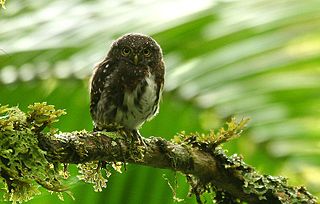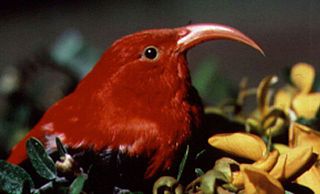Related Research Articles
Located about 2300 miles (3680 km) from the nearest continental shore, the Hawaiian Islands are the most isolated group of islands on the planet. The plant and animal life of the Hawaiian archipelago is the result of early, very infrequent colonizations of arriving species and the slow evolution of those species—in isolation from the rest of the world's flora and fauna—over a period of at least 5 million years. As a consequence, Hawai'i is home to a large number of endemic species. The radiation of species described by Charles Darwin in the Galapagos Islands which was critical to the formulation of his theory of evolution is far exceeded in the more isolated Hawaiian Islands.

The unspotted saw-whet owl is a small "typical owl" in subfamily Surniinae. It is found in Costa Rica, El Salvador, Guatemala, Mexico, and Panama.

The ʻakiapōlāʻau, pronounced ah-kee-ah-POH-LAH-OW, is a species of Hawaiian honeycreeper that is endemic to the island of Hawaii. Its natural habitats are dry and montane moist forests, and the only bird species on the island to occupy the woodpecker niche. The bird is 5.5 inches (14 cm) in length, and has an unusually curved beak-(a specialist species). The ʻakiapolaʻau is a pudgy bird which has a whitish bottom and tail, black legs, yellow chest, orangish head, black face mask and bill and gray black wings. The male's song is either a loud, short pit-er-ieu or a rapid warba-warba. Its various calls include an upslurred whistle, a short cheedle-ee warble, and a short sweet. Due to the recent disappearance of the Kauai nukupuʻu in the 1900s and the Maui nukupuʻu in the 1990s, leading to fears that they may be extinct, the ʻakiapōlāʻau may be the last of its genus. It is the only member of the subgenus Heterorhynchus, which has a woodpecker-like feeding habitat and exclusively preys on insects, in contrast to the nukupu'us, which were both insect-eaters and also hummingbird-like nectarivores.
The Usambara eagle-owl, also called the East African nduk eagle-owl or Vosseier's eagle-owl, is a taxon of owl in the family Strigidae. It is now regarded as a subspecies of Fraser's eagle-owl. It is endemic to the Usambara Mountains in Tanga Region of Tanzania.

The Costa Rican pygmy owl is a small "typical owl" in subfamily Surniinae. It is found in Costa Rica and Panama.

The Central American pygmy owl is a species of owl in the family Strigidae. It is found in Belize, Colombia, Costa Rica, Ecuador, Guatemala, Honduras, Mexico, Nicaragua, and Panama.

The Yungas screech owl, also known as montane forest screech-owl and Hoy's screech owl, is a species of owl in the family Strigidae. It is found in Argentina and Bolivia.

The Guatemalan pygmy owl is a small "typical owl" in subfamily Surniinae. However, some taxonomic systems consider it to be a subspecies of northern pygmy owl. It is found in Mexico, Guatemala, and Honduras.

The Maui nukupuʻu is a species of nukupu‘u Hawaiian honeycreeper that was endemic to the island of Maui in the Hawaiian Islands. The small, five-inch-long bird lived only in eastern Maui, where it was dependent on high-elevation mesic and wet forests of ʻōhiʻa lehua and koa. These two species of trees attract insects, causing the Maui nukupuʻu to have a higher chance of finding a meal near these trees. It was last sighted in the late 1990's, and is most likely extinct.

The Kauaʻi nukupuʻu was a species of nukupuʻu once found throughout parts of the Hawaiian island of Kauaʻi. It was an insect eater that picked out its tiny prey from tree bark. The males were yellowish with brown wings, while the females were grayish brown with a yellow throat streak.

The Oʻahu nukupuʻu was a species of nukupuʻu which was similar to its cousins from the Islands of Kauaʻi and Maui. It is yellowish greyish with a long hooked beak to find insects. This bird is now extinct due to human activity.

Hawaiian honeycreepers are a group of small, passerine birds endemic to Hawaiʻi. They are closely related to the rosefinches in the genus Carpodacus, but many species have evolved features unlike those present in any other finch. Their great morphological diversity is the result of adaptive radiation in an insular environment. Many have been driven to extinction since the first humans arrived in Hawaii, with extinctions increasing over the last 2 centuries following European discovery of the islands, with habitat destruction and especially invasive species being the main causes.

The foothill screech owl is a species of owl in the family Strigidae. It is found in Bolivia, Brazil, Colombia, Ecuador, Guyana, Suriname, and Venezuela.